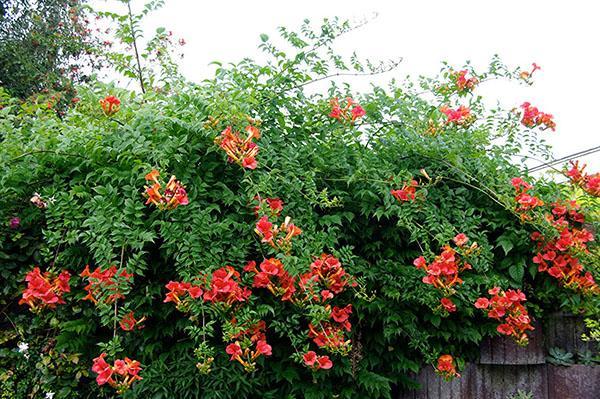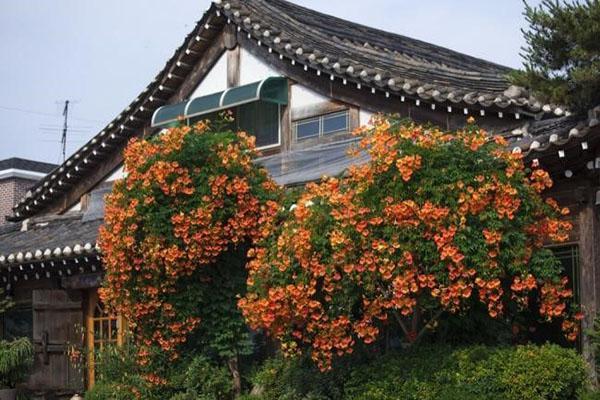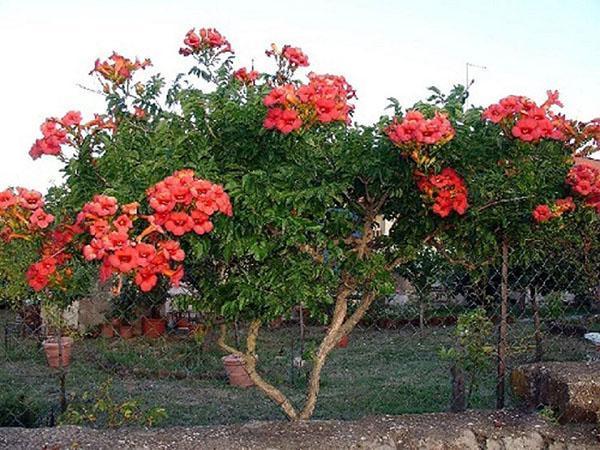Gardener's wise advice: how to care for Kampsis
 If the summer resident knows how to care for the Kampsis during the year, he will be able to grow a shrub of unusual beauty on his site. And how pleasant it is to contemplate its bright bloom all summer. Orange buds with a reddish tint are scattered against the background of a green blanket of leaves. The plant miraculously tolerates both dry periods and heat and refreshing coolness. With its help, gardeners create original arches and flower corners. Under them it is pleasant to gather with friends or in solitude to dream about the future. Let's take a closer look at how to take care of a blooming liana in a summer cottage.
If the summer resident knows how to care for the Kampsis during the year, he will be able to grow a shrub of unusual beauty on his site. And how pleasant it is to contemplate its bright bloom all summer. Orange buds with a reddish tint are scattered against the background of a green blanket of leaves. The plant miraculously tolerates both dry periods and heat and refreshing coolness. With its help, gardeners create original arches and flower corners. Under them it is pleasant to gather with friends or in solitude to dream about the future. Let's take a closer look at how to take care of a blooming liana in a summer cottage.
How to care for Kampsis: basic principles of success

- reasonable watering;
- regular feeding;
- removal of weeds from the main trunk;
- protective measures against pests;
- disease prevention;
- planned pruning;
- preparation for winter.
As you can see, the principles of how to care for Kampsis are not complicated at all. The main thing is to do everything on time and with wisdom.
Reasonable approach to watering and feeding
 Despite the resistance of the vine to dry periods, it needs regular moisture. Therefore, it is necessary to carefully monitor its need for moisture. If there is a shortage, water, if there is an excess, take a break.
Despite the resistance of the vine to dry periods, it needs regular moisture. Therefore, it is necessary to carefully monitor its need for moisture. If there is a shortage, water, if there is an excess, take a break.
A good example of how to care for Kampsis is provided by gardeners who regularly feed the vine. If it is planted on poor soil, then flowering will be short-lived without fertilizer. Therefore, it is necessary to periodically introduce into the soil nitrogen-phosphorus feeding... In gratitude, the plant will give an abundance of bright buds.
For the comfortable development of kampsis, you can mulch the near-stem area of the plant. This will help retain moisture during droughts.
Protection against pests and weeds
 In many European countries, rooting campsis grows, which is called tekoma. He is loved for the huge tubular buds of orange or scarlet, collected in small bouquets. When they abundantly cover the bush, the suburban area resembles a valley strewn with many bright flowers. Of course, such a plant needs regular weeding of a near-stem plot of land. Perform it as it appears weeds.
In many European countries, rooting campsis grows, which is called tekoma. He is loved for the huge tubular buds of orange or scarlet, collected in small bouquets. When they abundantly cover the bush, the suburban area resembles a valley strewn with many bright flowers. Of course, such a plant needs regular weeding of a near-stem plot of land. Perform it as it appears weeds.
Experts have noticed the special endurance and winter hardiness of rooting kampsis, which easily tolerates temperature extremes. It is not afraid of pests and is resistant to disease. In extreme cases, if the plant suffers from excess moisture, its roots begin to rot. And in dry, sultry weather, aphids "settle" on the leaves and buds, which feed on the sap of the plant, bringing harm to it. It is easy to get rid of it if you treat the plant with liquid laundry soap.
The high level of winter hardiness makes it possible to grow Kampsis in Siberia, especially in the southern regions. The main condition is proper care, feeding, pruning and high-quality shelter for the winter.
Planned plant pruning to create a corner of paradise
 In order for Kampsis to successfully develop and decorate the summer cottage with bright colors, you need to constantly monitor its growth. In order not to damage the flower, you need to know how to cut the campsis in the fall or early spring. Experts advise to remove weak shoots from the bushes at the end of the growing season.At the same time, leave strong branches, cutting them to 3 buds.
In order for Kampsis to successfully develop and decorate the summer cottage with bright colors, you need to constantly monitor its growth. In order not to damage the flower, you need to know how to cut the campsis in the fall or early spring. Experts advise to remove weak shoots from the bushes at the end of the growing season.At the same time, leave strong branches, cutting them to 3 buds.
It is important to regularly remove the shoots of the plant twice a season.
 Scheduled pruning of Kampsis in the spring is done before the buds begin to swell. Several strong shoots are chosen on the bush, from which the crown will form. The rest are removed with pruning shears. When the vine releases new shoots, they are directed to a support, for example, a mounted trellis. This procedure is repeated 3 or 4 years in a row.
Scheduled pruning of Kampsis in the spring is done before the buds begin to swell. Several strong shoots are chosen on the bush, from which the crown will form. The rest are removed with pruning shears. When the vine releases new shoots, they are directed to a support, for example, a mounted trellis. This procedure is repeated 3 or 4 years in a row.  During this time, the trunk and branches will grow to the desired size, which will allow you to trim the kampsis to form a crown in the form of a tree, a bush or a wide flowering canvas on a trellis.
During this time, the trunk and branches will grow to the desired size, which will allow you to trim the kampsis to form a crown in the form of a tree, a bush or a wide flowering canvas on a trellis.
To rejuvenate the vines, it is advisable to completely cut off the shoots up to 30 cm in height.
Often, many branches grow in the ground area of the flower, which interfere with the successful development of the vine. They must be removed as they emerge, leaving strong skeletal branches. In the spring, Kampsis needs sanitary pruning (dry, frozen or weak specimens are removed).
Preparing a plant for cold weather
 As you know, an exotic liana is not afraid of severe frosts, but in mid-latitudes it needs additional protection. For example, if you grow kampsis in the Leningrad region, it is advisable to hide its shoots under a warm "blanket". In late autumn, when there is no foliage on the branches, they are removed from a wooden or metal support and laid on the ground. Then a reliable shelter is prepared using various materials for this:
As you know, an exotic liana is not afraid of severe frosts, but in mid-latitudes it needs additional protection. For example, if you grow kampsis in the Leningrad region, it is advisable to hide its shoots under a warm "blanket". In late autumn, when there is no foliage on the branches, they are removed from a wooden or metal support and laid on the ground. Then a reliable shelter is prepared using various materials for this:
- spruce spruce branches;
- sawdust;
- hay or straw;
- dry foliage.
Be sure to put a plastic wrap on top. Under such a shelter for the winter, Kampsis is not afraid of severe frosts and temperature drops.
If a vine winds along an arch or a fence, for the winter its roots are sprinkled with sand, and the branches are wrapped in polyethylene.
Original supports for exotic liana
In summer cottages, there are various types of supports for climbing plants:
- trellis;

- arches;

- pergolas;
- lattices;
- gazebos;
- obelisks.
With their help, they mask unsightly outbuildings, decorate houses or divide a personal plot into zones. But the main purpose of the supports is to support the climbing vine. Many gardeners have made similar designs for Kampsis with their own hands. Indeed, in the natural environment, a flower winds along the trunks or branches of trees, and in the garden you simply cannot do without them. The original plant looks on a metal arch, which is built from two supports and a vaulted, rectangular, round or elongated ceiling.
 A simpler option is constructed from wood, metal wire or synthetic ropes. It is easy to dismantle such a structure in late autumn in order to hide the branches of the vine in a safe shelter. In addition, they are often transferred to a new place if the plant has aged and lost its attractive appearance. But how to destroy kampsis on the territory of the summer cottage? The easiest way is to prune the branches to a comfortable size and then spray with herbicide. The procedure is done carefully so as not to damage the plants growing nearby.
A simpler option is constructed from wood, metal wire or synthetic ropes. It is easy to dismantle such a structure in late autumn in order to hide the branches of the vine in a safe shelter. In addition, they are often transferred to a new place if the plant has aged and lost its attractive appearance. But how to destroy kampsis on the territory of the summer cottage? The easiest way is to prune the branches to a comfortable size and then spray with herbicide. The procedure is done carefully so as not to damage the plants growing nearby.
Before using the drug, you should carefully read the instructions.
The use of kampsis in landscape design

Original vines with openwork foliage and bright buds effectively decorate:
- hedges;
- gazebos;

- walls of houses;
- entrance arches;

- terraces.
 They climb rapidly on any surface thanks to their tenacious roots. As you can see in the photo, Kampsis in landscape design is a vivid proof of this. In addition, the plant is wonderfully combined with clematis. You can plant lavender at its foot or geranium... Throughout the season, the vine will delight the eye with its bright colors.
They climb rapidly on any surface thanks to their tenacious roots. As you can see in the photo, Kampsis in landscape design is a vivid proof of this. In addition, the plant is wonderfully combined with clematis. You can plant lavender at its foot or geranium... Throughout the season, the vine will delight the eye with its bright colors.
 Unfortunately, sometimes it happens that Kampsis does not bloom. Why is this happening? There are several reasons:
Unfortunately, sometimes it happens that Kampsis does not bloom. Why is this happening? There are several reasons:
- unexpected frosts in spring;
- root system disease;
- climatic conditions (cold summer);
- plant age.
 Despite this, the flower adorns the summer cottage with lush greenery, under which you can hide from the summer heat. And, perhaps, the moment will come when bouquets of orange buds will appear on it.
Despite this, the flower adorns the summer cottage with lush greenery, under which you can hide from the summer heat. And, perhaps, the moment will come when bouquets of orange buds will appear on it.